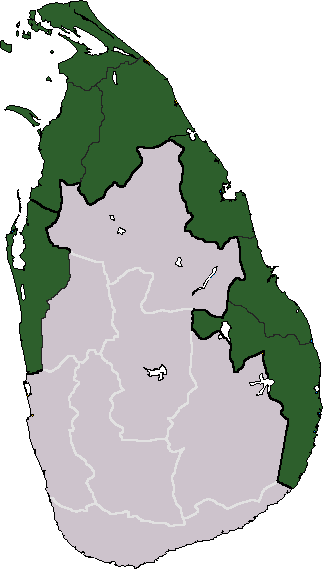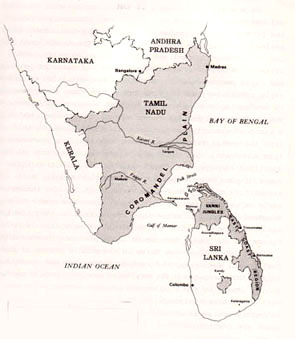
SANGAM.ORG
Ilankai Tamil Sangam, USA, Inc.
Association of Tamils of Sri Lanka in the USA
by Karhegesu Sivathamby, Sunday Observer, April 16, 2006
|
The significance of the North-East is that this area has all those 'places' the Sri Lankan Tamils have been living within known history. The only area outside the North-East which has had a traditional Tamil population was the North-Western border from Puttalam to Negombo which has been the area of the 'Bharathas,' the Tamil community from the Southern tip of Tamil Nadu - Tuticorin. |
The last few weeks have seen the reassertion of the political demand by a few sections of the East for secession of the East from the North-Eastern province.
Ever since the North-East was made a reality in Sri Lankan politics through the Indo-Sri Lankan Accord (the 13th amendment to the constitution) there have been demands made openly and discreetly for separating the East from the North.
From a non-Tamil point of view, there may be compelling reasons for dislodging the geographical togetherness of the North-East.
 |
| Areas of historic Tamil habitation in Sri Lanka |
The significance of the North-East is that this area has all those 'places' the Sri Lankan Tamils have been living within known history. The only area outside the North-East which has had a traditional Tamil population was the North-Western border from Puttalam to Negombo which has been the area of the 'Bharathas,' the Tamil community from the Southern tip of Tamil Nadu - Tuticorin.
The argument is that the North-East had the linguistic predominance of Tamil language. In fact, the Federal Party, which made the first effective claim on a geographical basis, referred to this area as the traditional Tamil-speaking region. That plea was made on behalf of the Tamils and Muslims of the area.
Unlike the Muslims outside the North-East, the Muslims of the North-East, except for the small pocket of Muslims of the 'Sonaha Theru' of Jaffna town, are largely land based and agrarian based.
Thus they constitute an integral part of the land and the soil. However, the history of the ethnicity of Sri Lanka has tended to view groups in terms of religio-cultural identity, not so much in linguistic terms.
The fact that the North-East had Tamil residents has been accepted since the Bandaranaike-Chelvanyagam Pact (1959). The consequent riots outside the North-East in the sixty's and the seventy's often led the governments of the day to send Tamils to the North and East by shiploads and train loads during unmanageable riot times.
The emergence of the Tamil militant youth movement, which at its initial included the Muslims of the East, brought in a sense of unity among the different Tamil regions of the North and the East. S.J.V. Chelvanayagam, during the early days of Federal Party, was keen on having the leadership also from the East. Thus, the significance of Rajawarothayan and Egambaram. In those early days C. Rajadurai of Batticaloa was taken as the symbol of the North-East Tamil youth fraternity.
In a way it was the Sinhala Only and the continued neglect of Tamil grievances that led to a consolidation of the North-East as a political entity. The Indian government understood this reality better than J.R. Jayewardene.
This political consolidation of the North-East as the traditional homeland of the Sri Lankan Tamils has had some problems. There have always been a Batticaloa-Jaffna divide which was always used against this unity.
The Tamils of Batticaloa have had genuine political grievances of their own. It had gone so far deep as to take C. Rajadurai away from the TULF and the North-East unity by J.R. Jayewardene himself. It is at this point of time that one feels the need for understanding the geographical spread of the Sri Lankan Tamils and their unity necessitated politically.
A wider look at the entire island in terms of its demography is quite relevant here. The pre-colonial history and the colonial history of the Protuguese and the Dutch periods created the need for a division on the basis of the geography of the traditional Sinhala areas - the Udarata and Pahatha rate...The up-country and the low-country Sinhalese.
This division was maintained in the census reports until about 1981/2. Technically speaking, the Sinhalese of the Sabaragamuwa region have a distinct cultural trait-from the dances to the drums. I understood that there are dialectal variations in the Sinhala language as spoken in Rajarata and Rohana.
Even the Muslims, in spite of their religious oneness, have differences among them in terms of their places of residence. The Muslims of the Galle Fort area are very much different in complexion and spoken idiom from the Muslim peasant of Batticoloa. I know very well that the late A.M.A. Azeez was seen more as a Jaffna Muslim than a Colombo Muslim.
Likewise among the Sri Lankan Tamils, too. An objective view of the Tamils in terms of their local cultures would reveal that there are distinguishable regions of Tamil residence.
The language is the same. The social organisation is very much the same, but in terms of regional living, social hierarchies and religious groupings, there are regional specifics. The need for political unity should not distract one from this regional reality.
Starting from the East and going towards the North and then the west the following regions are very clearly seen: the Batticaloa region, the Trincomalee region, the Vanni region, the Jaffna region and the Mannar region. If one does a comparative analysis, one would see regional variations in caste formations, religious organisations, availability of land, level of politicisation, etc.
There is an equally distinguishable way of marking two major areas. One could call one the area of the 'Thesawalamai' operations and the other the area of the 'Mukkuw' law operations. The Mukkuw law was the governing law for the Batticaloa region. The Thesavalamai system roughly speaking covers the entire Northern areas. These two systems are not contradictory to each other, but historical evolutions determined by history and geography. The Dravidian kinship system is basic to both these system. The Sinhalese too, have adopted the same.
More specifically the family, the nuclear and the extended bases constitute the pivot of almost all social relations. Of these, the Batticaloa region is a very significant one. This was never a part of the Kingdom of Jaffna, nor was it part of the formal Vanni which extended up to Trincomalee. Historically speaking, Batticaloa did not undergo the same colonialist experiences as Jaffna or Mannar. It was virtually a unit of traditional self-rule, with perhaps the over-lordship of the latter day Kandyan Kingdom.
A close look at Batticaloa reveals two noticeable aspects. One is that it retains the organisational unit of the 'Kudi' system. One draws the Kudi system is buttressed by the cultic worship of 'Kannagai' and also 'Mariyamman'. At that level there is no place for the Sanskritised Hindu pantheon.
The second almost neglected aspect is that the Batticaloa region from Mannampitiya to Kokkadicholai has a number of eminent Siva temples. There is also a strong tradition of classical manuscriptology - ola manuscripts - dealing with classical Hindu themes and 'Itihasas' are found in abundance.
It was the late D. Sivaram who wanted to highlight this aspect. Unfortunately, he didn't have time to do it. The emphasis on this aspect is very essential because Batticaloa is a region with Tamilian folk forms, specially the 'Kuttu' and 'Pattu.' The Batticaloa Tamil folk songs are, of course, the preserve of the Muslim women of the South-East.
The socio-cultural scene in Trincomalee is different. There again, the Trincomalee town with its harbour is one unit, but more important is the interior regions of Muthur, Kinniya, etc. The cultural impact of the 'Chola' rule can yet be seen in the Sivan temples of the Trincomalee district.
 |
| Area where Tamil currently spoken in Sri Lanka & India, map from TamilNation.org |
Coming to Vanni one would notice that, it is a geographical result of historical isolation. But ever since the 1930s and especially after the 1960s, there have been new settlements in the major Tamil Vanni areas. So much so today the Vanni people and the settlers from Jaffna have become fully integrated. Mullaitheuw has been an important agrarian and a fishing region.
The history of Jaffna is too well known to be repeated here. Jaffna was a political unit by itself and had its own Kingdom. The rule of the Portuguese and the Dutch and thereafter the British had enabled the slow evolution of the Sanskritisation of the Hindu traditions. In Mannar, of course, since the Portuguese days Catholicism has been a dominant factor, but the place is equally holy to the Hindu traditions.
Thus it has been historical circumstances that have led to a sense of regionalism. It should be said to the credit of the Sinhalese politicians that the manner they wanted to handle independent Sri Lanka has led to an irretrievable polarisation in to Sinhalese, Tamils and the Muslims.
The development of Sri Lankan Tamil literature has been a great unifying factor among the Tamils of Sri Lanka. On this note, emphasis has not been placed on the Tamils of Indian descent of Sri Lanka, commonly referred to as the 'Malayagam people.' They are now in cultural terms part of the Sri Lankan Tamil complex.
The unity of this country depends on the political individuality of each of the national groups. The Sinhalese, the Tamils and the Muslims to play on minor differences would only lead to deepen of the bonds of unity.
Getting to Know Sri Lankan Tamils - part 1
Getting to Know Sri Lankan Tamils - part 2
© 1996-2025 Ilankai Tamil Sangam, USA, Inc.